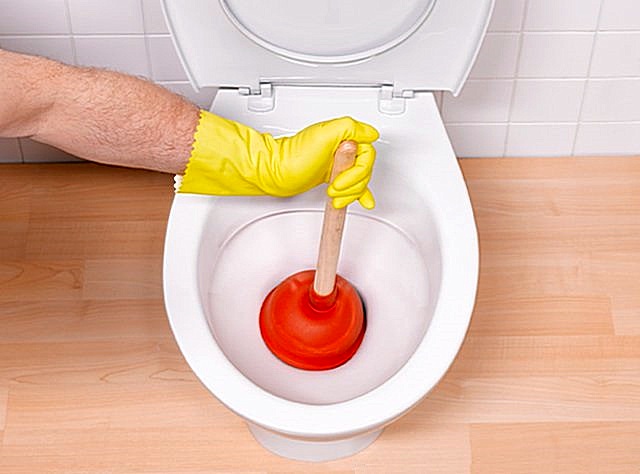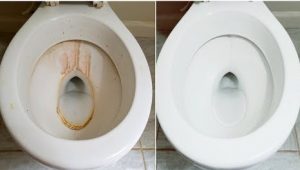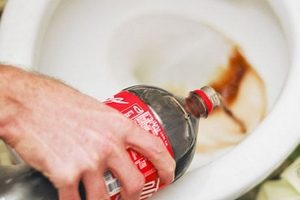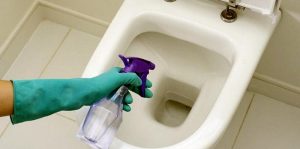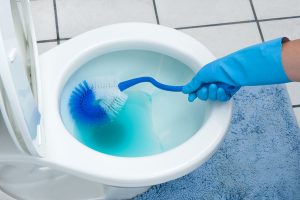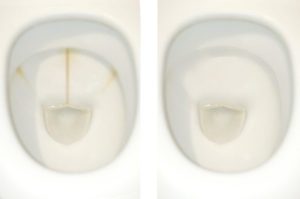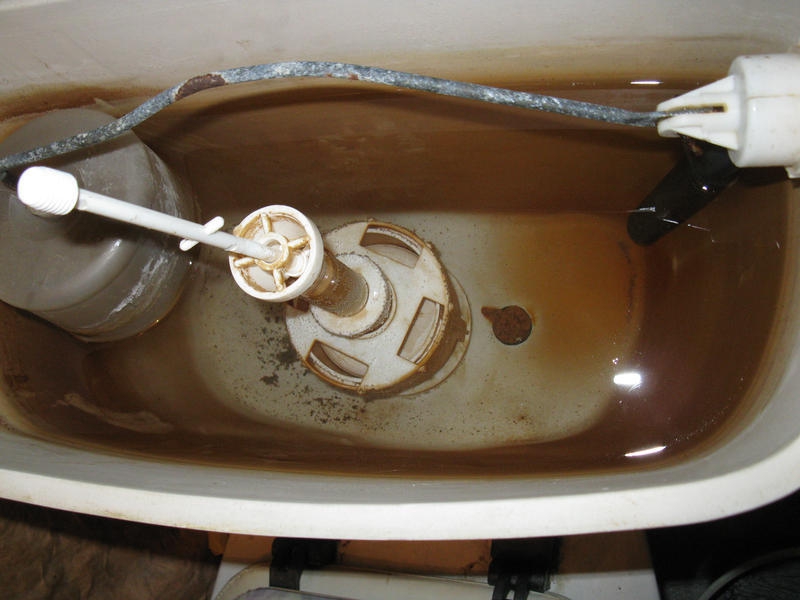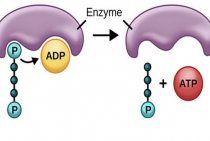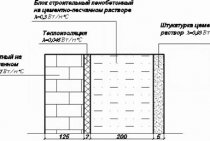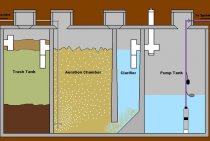Effective Ways to Clean Plumbing
The easiest way to use ready-made household chemicals. Usually, the same products that you use to deal with limescale will help get rid of rust on sanitary appliances. They can be alkaline or acid based, but all are quite aggressive and unsafe. Be sure to use durable rubber gloves to clean the toilet. Never mix different chemicals, as a chemical reaction may start, releasing hazardous substances (eg chlorine).
Of the most effective and well-known means, one can name Domestos, Sif, Sillit, SANO Antikalk, Sanfor and others. Means in the form of liquids and gels are preferable to powdered ones, as they damage the surface less.
Before cleaning, it is better to turn off the water supply to the tank so that the product is not washed off ahead of time.
In addition to ready-made products, you can clean the toilet from rust with improvised means. The most famous are the following:
- Organic acids: acetic, citric, oxalic. Few people have oxalic acid in its pure form, so we mention it only in case it is still in the house. By the way, the effectiveness of Surge paste is based on the action of oxalic acid. To remove rust from the toilet, it is enough to cover the rusty spots with a piece of cloth soaked in acid for 10 minutes. Then rinse the device with clean water.
- An inorganic acid that is part of the electrolyte for batteries. You can clean the toilet from rust with this tool in the same way as in the previous paragraph.
- Everyone knows drinks: Pepsi and Coca-Cola, Sprite, Fanta, 7UP. With shine removes not only rust, but also limescale and urinary stone. And when flushing, it will also eliminate fat deposits on the walls of sewer pipes.
- The most exotic way to remove rusty stains is toothpaste. Of course, you should not buy toothpaste for this purpose, but it is quite possible to use a tube of one that for some reason did not fit or did not like the taste. What’s more, you don’t need a lot of it. It is enough to squeeze 3-4 cm of paste onto the brush and wipe the surface covered with rust. It will not work to clean a thick layer in this way, but the paste can easily cope with not too old deposits.
In order not to spend a lot of time trying to remove rust from the toilet, you need to prevent it from forming a thick layer. Regular cleaning will keep your plumbing fixtures free of unsightly and unhygienic deposits of calcium and iron salts.
Causes of rust
Rust is a product of the oxidation of various alloys. There are several factors that contribute to its formation on the surface of plumbing and in the cistern:
- Old pipes. During the construction of modern houses, pipes made of metal-plastic, polypropylene or PVC are installed. However, for the most part, the plumbing system consists of cast iron and steel pipes. As a result, water, moving through the pipes, absorbs sand and other impurities, which settle on the surface of the toilet bowl.
- With a long service life of plumbing, there is constant contact with the liquid, which leads to its corrosion. In most regions, water sources are enriched with various metals. Oxidized iron particles combine with water and it, in this composition, enters the house, leaving an unpleasant plaque on the toilet.
- Leaking liquid from the reservoir due to a poorly adjusted valve ensures constant contact with it, which causes brown smudges to form on the ceramic coating.
- For the manufacture of sanitary ware, faience or porcelain are used. The low price of faience products is directly proportional to the quality of their manufacture.Such a surface is unstable to any mechanical stress, from which it becomes rough very quickly. Various impurities and dirt accumulate in these irregularities. Porcelain products are much more resistant to plaque.
In order to get rid of this problem forever, it is necessary to eliminate the root cause of its occurrence.
Causes of rust
In many regions of the country, water flowing in pipes is saturated with iron salts. If this is due to the peculiarities of the composition of local waters, then it is possible to combat the appearance of sediment from iron salts only by adding special tablets to the tank. These tablets, slowly dissolving, give the water a pleasant aroma, and sometimes color. But most importantly, they prevent the appearance of precipitation on the walls of the toilet bowl.
The third reason for rust in the toilet is a poorly adjusted cistern. Take a closer look: if water constantly flows from the tank in a thin stream, then you need to adjust the float or replace the entire tank. As a rule, rust appears precisely along the edges of an ever-flowing trickle. You can clean the toilet to perfection, but if the cistern leaks, the streaks form again.
And the last. The rougher the surface of the device, the faster limescale, urinary stone and rust appear on it. Porcelain toilet bowls have the smoothest surface, faience toilet bowls with glazed walls are not far behind them. Conventional sanitary ware has a more porous and less smooth surface. The older the toilet, the less smooth its surface and the sooner rust will form on it. Perhaps, before deciding how to clean the toilet from rust, it is worth changing the plumbing. It's worth doing this from time to time for hygiene reasons.
Expert answers
Olga Oleinik (Maletina):
I have a faucet in my apartment. When I start cleaning, I turn off the tap, salt the water from the drain tank, after washing it, rust accumulates there too. I put on long gloves, remove the water from the toilet. I process SUNFOR. SANITA antirust gel, SARMA, SANITARY liquid. Sometimes I fill in almost half a liter of SANITARY. I let it sit for a few hours. I named several names, choose for yourself. Freshness guaranteed. But the water is bad, you have to deal with it. Success.
dron ivanov:
Install a water filter.
bonbon bonbonovich:
Shumanit will help her
Sexy Sprat…:
Change the inside of the tank. .
Alena Barkova:
fix the leak
Yours among strangers:
Change the gasket so that the water does not leak
Anna:
Domestos, dark blue bottle
Grandfather Au:
bad water pipes need to be changed in the house
The Scarlet Flower:
So the gasket needs to be changed so that it doesn’t leak, what’s the point of spending money on detergents, it’s better to pay the plumber and he will eliminate the shortcomings.
Alisa Karasevich:
Throw toilet tablets into the toilet bowl. The water will drain blue (or green), but rust does not stick, they are cleansing (if normal, and not just for the sake of color).
KIPYATKOFF:
Fans of Coca-Cola, Fanta and Sprite are in for a nasty surprise. It has long been known that these drinks can be used not only directly for the purposes for which it is intended, but also for cleaning, for example, the toilet bowl. But, probably, not everyone knows that this drink can destroy a piece of fried meat - put a steak in a plate with Cola, and in two days you will not find it there. The active ingredient in cola is phosphoric acid. Its pH is 2.8. In 4 days, it can even dissolve nails. By the way, to transport Cola concentrate, the truck must be equipped with special pallets designed for highly corrosive materials. Cola distributors have been using it to clean their truck engines for 20 years.
- To remove rust stains from the chrome bumper of a car, rub the bumper with a crumpled sheet of aluminum foil soaked in Cola; - to remove corrosion from batteries in a car, pour a can of Cola on the batteries and the corrosion will disappear; - to unwind a rusted bolt, moisten a rag with Cola and wrap it around the bolt for a few minutes; — perfectly launders greasy stains on the wooden decks of yachts; - To clean clothes from dirt, pour a can of Coke on a pile of dirty clothes, add washing powder and wash in the machine as usual. Cola will help get rid of stains. It will also clean the windows in the car from road dust; - to clean the toilet, pour a can of Coke into the toilet and ... do not flush for an hour. Citric acid in Cola will remove stains from faience. By the way, in many states in the US, the traffic police always have 2 gallons of Cola in their patrol car to wash blood off the highway after an accident. (do you still drink cola?)
Julie:
do you have it made of iron?
mia:
acid
lazy wall:
domestos, sanox very well kill germs and remove rust
Clover four-leaf:
Don't mess with rust!
Shashko Natalia:
Try sprinkling in powdered ascorbic acid, waiting a bit, then rinsing thoroughly.
Complete happiness))):
the tool where it is written REMOVES RUST
Polyglot Orlovskaya:
It's not rust, it's urea. you need products with acid or where it says ANTI-RUST, if it doesn’t help, scrape with an old knife (with an old one, because the new one will come in handy in the kitchen)
in reserve:
In a car shop, buy a rust converter, aka phosphoric acid. you can still smear ACE, such bleach is also not bad.
Grandfather Au:
First, don't run and use Cilllit
Love:
domestos - protects and kills microbes is also good, but Sanoks is stronger, instantly removes rust and does not require any effort. Sanoks is better.
Pashka:
I use power
Olga:
Battery fluid (acid)
pirate:
a bottle of Coke!
Michael:
adjust the toilet valve to shut off the water as the tank fills up
k-stimul:
coca cola
How to clean toilet rust
To get rid of rust in the toilet, for a start, you can try to apply simple and elementary methods related to the use of improvised means. If they do not give a positive result, then you can already resort to household chemicals, which are more aggressive, but are considered much more effective.
With the help of folk methods
Among the folk methods that successfully cope with traces of corrosion, the following are distinguished:
- Vinegar. If a layer of rust has accumulated at the top of the bowl, then take a small piece of cloth, moisten it abundantly in vinegar and apply it to the damaged area like a compress. After 60-120 minutes, the rag is removed and the bowl is washed with soapy water and clean water.
- Peroxide and ammonia. Substances are mixed, taking 1 part of peroxide to 10 parts of ammonia. Next, the solution is poured into a spray bottle, sprayed on pollution and left to interact for several hours. The toilet is then simply flushed with clean water. It should be remembered that ammonia has a sharp chemical smell. Be sure to use a respirator and ensure that the bathroom is well ventilated.
- Oxalic or hydrochloric acid. These substances can be used if the rust is at the very bottom of the toilet. It is permissible to simply pour them into water and leave for an hour or two to completely destroy the rust. Then the drain is cleaned with a brush, and the toilet bowl is washed with soapy water and clean water.
- The most unusual way, but at the same time one of the most effective is the use of Coca-Cola. The drink is applied in the same way as acids. It also pours into the toilet, but the interaction time needs to be increased - up to 12 hours.
Household chemicals
Store tools that can remove rust are divided into several types:
- Abrasive.These are any cleaning products that consist of fine solid powder particles. For example, this includes Pemolux or Chistin. The powder is applied to a sponge and the traces of rust are diligently cleaned off. The disadvantage of such means is that solid particles will somehow damage the surface, which means that in the future these defects will provoke the appearance of corrosion again and again.
- Based on alkali. Such detergents are applied to the contaminated area for 20-30 minutes, and then washed off with water. They are considered quite effective, but they are unlikely to be able to remove old traces of rust.
- Acid based. Acid effectively dissolves rust stains, but you need to work with such products only with rubber gloves, goggles and a respirator. Acids are great for earthenware and porcelain toilets, do not damage the surface and at the same time remove other contaminants, including plaque and stains.
In order for the toilet to shine and not be subjected to another destruction, it must be cleaned in a timely and regular manner. After all, it is obvious that getting rid of rust in the early stages of its manifestation is much easier than getting rid of old and stubborn stains.
Best Answers
tahir shesterin:
coca cola helps
j_dee:
caustic soda, or ordinary. then to soothe something else with chlorine.
Katarina Rivercross:
toilet duck. typhoon. brush. gloves. hands at the end!
Natasha:
Pour acid in there. Sanox gel for example.
Svetlana:
First Cilit bang to remove rust and limescale, and then Domestos for disinfection. The disinfectant exposure time is at least 20 minutes.
Gold-diamond:
Pour domestos at night and clean with a whisk in the morning, it will be white and white in the morning.
☼ḂαρɞɑǷα ‟ﺮ:
Whiteness will wash everything.
Naumenko:
splurge on a new one. someone else's work is not worth it. the view will still be terrible.
alex pupkin:
Use an acid solution. For example, citric acid or a weak solution of sulfuric acid. Just do not overdo it and do not suffocate. Acid dissolves calcium well!
Light:
Yes, change it - and the problem is settled. If the toilet is very neglected, it can no longer be brought to an ideal state.
Full moon:
Domestos will help you.
Elizaveta Kirillova:
Sanoks well washes rust or any medium containing acid .. And if limescale has already formed inside, then you can’t clean it off with any means. It is necessary to scoop out water, for example, with a ladle, pour it with Sanoks and then scrub it with something like a screwdriver or chisel.
Linocka Alinocka:
eats liquid CIF for washing toilets, washes at a time, you don’t even need to make an effort
gerta521:
Buy HARPIK, it eats everything. I can also add: Silit beng and domestos will not cope, do not waste your money and your work in vain.
Zinaida:
It is better to change to a new one.
Causes of rust
In many regions of the country, water flowing in pipes is saturated with iron salts. If this is due to the peculiarities of the composition of local waters, then it is possible to combat the appearance of sediment from iron salts only by adding special tablets to the tank. These tablets, slowly dissolving, give the water a pleasant aroma, and sometimes color. But most importantly, they prevent the appearance of precipitation on the walls of the toilet bowl.
The third reason for rust in the toilet is a poorly adjusted cistern. Take a closer look: if water constantly flows from the tank in a thin stream, then you need to adjust the float or replace the entire tank. As a rule, rust appears precisely along the edges of an ever-flowing trickle. You can clean the toilet to perfection, but if the cistern leaks, the streaks form again.
And the last. The rougher the surface of the device, the faster limescale, urinary stone and rust appear on it. Porcelain toilet bowls have the smoothest surface, faience toilet bowls with glazed walls are not far behind them.Conventional sanitary ware has a more porous and less smooth surface. The older the toilet, the less smooth its surface and the sooner rust will form on it. Perhaps, before deciding how to clean the toilet from rust, it is worth changing the plumbing. It's worth doing this from time to time for hygiene reasons.
Why does rust form?
There can be several reasons why rust appears inside the toilet bowl:
- Deterioration of water pipes. Old communications were laid from metal without a protective coating, which, as it is used, is somehow destroyed and, as a result, corroded. Oxide molecules get into the water and inevitably flow first into the drain tank, and then into the toilet itself, which causes rusty streaks and plaque.
- Running water with a high content of iron in the composition. It is clear that this fact leads to the appearance of rust not only on the toilet, but also in the cistern. In order to make sure exactly this reason for the appearance of a rusty coating, you should analyze the water, and then use either filters or special tablets that will prevent a similar rust problem.
If you find that even small traces of corrosion have appeared in your toilet bowl, then you definitely shouldn’t be upset, and even more so in a hurry to buy new plumbing. It is quite possible to fix the problem yourself and your toilet bowl will again shine with cleanliness and brilliance.
Reasons for the formation of plaque and rust in the toilet bowl
The water that we use contains a large number of various impurities. Even after several stages of cleaning, some of them are preserved, including limestone. Once in the toilet bowl, they settle on the walls and the drain mechanism.
First, the limestone forms a small layer over the entire surface. But if it is not removed in time, stone deposits gradually begin to form. Removing hard deposits is much more difficult than a thin layer of limestone. Also, old plumbing pipes add rust. It settles on the inner surface of the tank and becomes denser and thicker over time.
Small particles of rust settle on all internal elements of the tank, including the drain mechanism. Because of this, its normal functioning is disrupted, and if the plaque is not removed, the mechanism will fail. Water will start to flow out of the tank. Pathogenic bacteria, mold, and an unpleasant odor will develop in it.
How to remove rust and yellow plaque at home
You can remove limescale and rust yourself. This is done both with the help of store-bought cleaning products, and folk methods.
It should be borne in mind that you can achieve maximum results only by choosing the right cleaning agent. You need to choose a tool taking into account the material from which the tank is made. So, for ceramic tanks, substances containing acids should be used, and for metal ones, softer alkaline solutions.
With store supplies
If a slight layer of limescale and rust has formed on the inside of the tank and the drain mechanism, they can be dealt with without the use of concentrated cleaners. To wash the tank, you can use "Pemoxol", "Cinderella", "Pemos" or "Myth".
In the event of a heavy raid, "heavy artillery" will be required: "Sanox", "Biocid-S". Means are able to remove any pollution in a matter of minutes.
Also on sale are gels that are especially popular:
- Cilit. There are several varieties designed to combat specific pollution: against rust, to remove limescale. In addition, Silit will remove dull spots and restore plumbing to its former shine.
- "Domestos". The substance has a thick viscous consistency, perfectly removes dirt and disinfects plumbing.
- comet.Perfectly copes with pollution of any intensity. But before use, plastic parts should be dismantled - the substance has a negative effect on them.
- "Toilet duck". An inexpensive tool that does an excellent job and refreshes plumbing.
- Sanita. Able to remove even old rust deposits.
- "Sanfor". An excellent tool that not only removes dirt, but also removes fungus and mold. They can clean all plumbing, as well as tiles.
Folk methods
For folk methods, the following means are used:
- Vinegar. Mix a small amount of table vinegar with water. The resulting mixture must be poured into the tank and left for several hours. After that, drain the solution and carefully wipe the inside of the tank with a hard sponge.
- Toothpaste. You need to make several holes in the paste tube and put it inside the tank. Each time the water is drained, a self-cleaning process will take place.
- Lemon acid. You will need 5-10 sachets of acid. It is necessary to pour their contents into the tank and pour water at room temperature. Stir the solution thoroughly until all acid crystals are completely dissolved. Leave the composition for 3-4 hours, then rub the walls of the tank with a hard sponge or brush.
- Coca Cola. A rather non-standard option, but sparkling water perfectly removes plaque and rust. Pour a few bottles of Coca-Cola into the tank, leave it for a couple of hours. After this time, rub the walls with a brush.
Removing plaque and rust is quite simple
But in order not to waste time on lengthy cleaning, it is important to regularly wash the tank from the inside. After all, you can remove fresh deposits with an ordinary damp cloth, without resorting to the use of strong chemicals.
